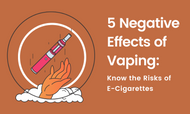5 Negative Effects of Vaping: Know the Risks of E-Cigarettes
Posted by Anastasia on Feb 3rd 2023
Vaping has become increasingly popular in recent years, especially among young people. Many people believe that vaping is a safer alternative to smoking cigarettes, however, research has shown that vaping can have negative effects on one's health. In this blog post, we will be discussing the five most significant negative effects of vaping.
From lung damage to addiction, these risks are important to understand for anyone who is currently vaping or considering taking it up. This post will also provide information on how to quit vaping. It is important to note that quitting vaping is not easy, but with the right support and resources, it is possible. By understanding the harmful effects of vaping, one can make an informed decision about whether or not to continue using e-cigarettes.
Long-term side effects of vaping
- Lung Damage: Vaping can cause damage to the lungs, including inflammation, lung injury and in some cases, even death. The vapor from e-cigarettes contains harmful chemicals such as diacetyl, a chemical linked to a serious lung disease called bronchiolitis obliterans, commonly known as "popcorn lung." This condition causes the small air sacs in the lungs to become scarred and narrowed, making it difficult to breathe.
- Nicotine Addiction: E-cigarettes still contain nicotine, the addictive substance found in traditional cigarettes. Nicotine is a highly addictive substance that can lead to dependence and withdrawal symptoms when a person stops using it. Nicotine addiction can make it difficult to quit vaping and increase the risk of relapse.
- Secondhand Exposure: Vaping also poses a risk to those around the user, as the vapor contains harmful chemicals that can be inhaled by others. Secondhand exposure to the vapor from e-cigarettes can be harmful, especially for children, pregnant women, and people with pre-existing lung conditions.
- Impact on Youth: Vaping is particularly popular among young people and teens, and the use of e-cigarettes is increasing among this population. Nicotine is highly addictive and can harm the developing brains of adolescents and young adults. Moreover, early exposure to nicotine can lead to addiction and increase the risk of smoking cigarettes later in life.
- Other Health Risks: Vaping can also increase the risk of other health problems such as heart disease, stroke, and various types of cancer. Furthermore, the long-term effects of vaping are not yet known, and more research is needed to understand the full extent of the risks associated with e-cigarettes.
It's important to note that vaping is not a safe alternative to smoking cigarettes, and the negative effects of vaping can be just as serious as those of smoking. Quitting vaping is not easy, but with the right support and resources, it is possible. If you or someone you know is struggling with vaping addiction, it's important to seek help from a healthcare professional or a quitline.
First time vaping side effects
Some common side effects experienced by first-time vapers include dry mouth, throat irritation, coughing, and headaches. In some cases, nausea and dizziness may also occur. These symptoms are usually temporary and can be alleviated by reducing the frequency or amount of vaping.
However, it's important to note that some of these symptoms may indicate a more serious underlying condition, such as an allergic reaction to the ingredients in the e-liquid. If the symptoms persist or worsen, it's important to seek medical attention. Additionally, first-time vapers may also experience nicotine addiction and withdrawal symptoms if they are using e-cigarettes with nicotine.
Effects of vaping on the lungs
Vaping has been linked to a number of negative effects on the lungs. The aerosol produced by e-cigarettes contains a variety of harmful substances, including nicotine, propylene glycol, and other chemicals, which can cause lung irritation and inflammation.
One of the most concerning effects of vaping on the lungs is the development of popcorn lung, which is the common name for bronchiolitis obliterans. This condition is characterized by the inflammation and narrowing of the small airways in the lungs, which can lead to shortness of breath, coughing, and difficulty breathing. Studies have shown that diacetyl, a chemical used in some e-cigarette flavorings, can cause popcorn lung when inhaled.
Vaping can also cause damage to the cilia, which are the small hair-like structures that line the airways and help to clear mucus and other debris from the lungs. Damage to the cilia can lead to chronic bronchitis, a condition characterized by persistent cough and mucus production.
Another potential effect of vaping on the lungs is the development of lung cancer. While the long-term effects of vaping on cancer risk are not yet fully understood, studies have shown that the aerosol produced by e-cigarettes contains a number of carcinogens, including formaldehyde and acrolein.
Vaping may also worsen asthma symptoms, and aggravate underlying lung conditions like COPD.
It's important to note that vaping is a relatively new habit and more research is needed to fully understand the long-term effects of vaping on lungs. However, the available evidence suggests that vaping can have serious negative effects on lung health and it is not a safe alternative to smoking.
Some scary vaping facts
Vaping has become increasingly popular in recent years, but there are many scary facts about this habit that people should be aware of.
First, vaping can be highly addictive. Nicotine, the substance that makes tobacco products addictive, is also present in e-cigarettes and can lead to addiction. This can be especially dangerous for young people, as their brains are still developing and they may be more susceptible to addiction.
Second, vaping can have serious negative effects on lung health. The aerosol produced by e-cigarettes contains a variety of harmful substances, including nicotine, propylene glycol, and other chemicals, which can cause lung irritation and inflammation. Studies have also linked vaping to the development of popcorn lung, a condition characterized by the inflammation and narrowing of the small airways in the lungs, which can lead to shortness of breath, coughing, and difficulty breathing.
Third, vaping can be dangerous for pregnant women. Nicotine can harm the developing fetus and may lead to low birth weight and other complications. Furthermore, the chemicals in e-cigarette aerosol can also harm the developing fetus.
Fourth, Secondhand vapor can be harmful to others, particularly children and individuals with pre-existing respiratory issues.
Fifth, there have been reports of e-cigarettes exploding and causing severe burns, injuries, and even death.
Lastly, it's important to note that vaping is not a safe alternative to smoking, it's another form of nicotine addiction and the long-term health effects of vaping are not yet fully understood.
In conclusion, vaping may seem like a harmless alternative to smoking, but there are many scary facts that people should be aware of before starting this habit. It's important to consider the potential risks and negative effects on health before using e-cigarettes.
Conclusion:
In conclusion, vaping has become increasingly popular in recent years, but there are many serious negative effects associated with this habit. Nicotine addiction, lung irritation and inflammation, harm to pregnant women and their fetuses, secondhand vapor and explosions are just a few examples. Additionally, the long-term health effects of vaping are not yet fully understood. It's important to consider the potential risks and negative effects on health before using e-cigarettes and to seek help if you're struggling to quit. It's important to note that vaping is not a safe alternative to smoking, it's another form of nicotine addiction. The best option for a healthy lifestyle is to not start vaping or smoking.

